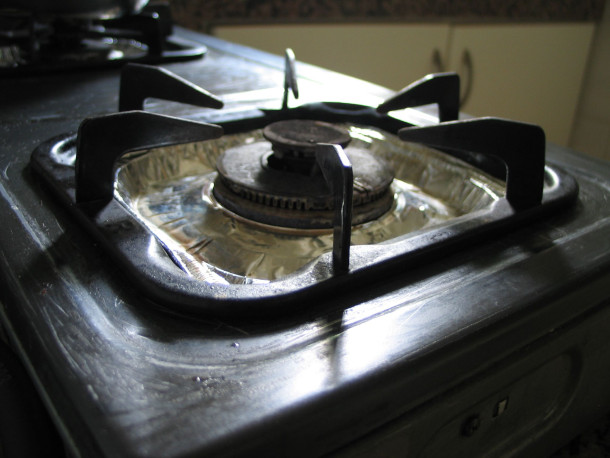Toxic Air in Utero
Air Date: Week of November 4, 2022

A 2022 study out of Europe found black carbon particles from pollution in the brains, lungs, and livers of fetuses. (Photo: Michael Kordahi, Flickr, CC BY-SA 2.0)
Before they’ve even taken their first breath, many if not most babies are exposed to air pollution that passes from their mother’s blood stream through the placenta. And an October 2022 study out of Europe found that the more air pollution a pregnant person is exposed to, the more black carbon particles from burning fossil fuels are found in the lungs, brain, and liver of the fetus. For more, Host Bobby Bascomb spoke with pediatrician Aaron Bernstein, the Interim Director of the Center for Climate, Health, and the Global Environment at the Harvard T.H Chan School of Public Health
Transcript
BASCOMB: It’s Living on Earth, I’m Bobby Bascomb.
Before they’ve even taken their first breath, most babies are exposed to air pollution that passes from their mother’s blood stream through the placenta. And a recent study out of Europe found essentially a smoking gun for that exposure. Researchers in Scotland and Belgium looked at 96 randomly selected non-smoking mothers and their fetuses for the study. They found that the more air pollution a pregnant person is exposed to, the more black carbon particles from burning fossil fuels are found in the lungs, brain, and liver of the fetus. That’s especially dire news for communities of color in the US which are disproportionately exposed to higher levels of pollutants. For more, I’m joined now by pediatrician Aaron Bernstein, the interim director of The Center for Climate, Health, and the Global Environment at the Harvard T.H Chan School of Public Health. Dr. Bernstein, welcome back to Living on Earth!
BERNSTEIN: Great to be with you, Bobby.
BASCOMB: So first off, please give us the basics of this study. What were the researchers trying to learn here? And how did they go about it?
BERNSTEIN: This is a kind of smoking gun study. Meaning, we already had studies showing that breathing air pollution was bad for pregnancies. That's been clear for a while. But people really want to take it to the mat. They want to know sort of exactly how this works. And, and what this study shows is that the air pollution that's outside gets inside the mother and crosses the placenta and gets into the baby. Prior to this study, we even had research showing that these air particles that they found in the fetus did get to the placenta. But this study not only showed that, they showed that they got into the cord blood and even into the fetal tissues, and perhaps most compellingly showed that the amount that gets into the fetal tissues is proportionate to the amount that the mother is exposed to. So, you know, this is a study that really makes very clear that the amount of air pollution that, you know, people who are pregnant get exposed to, is really going to be proportionate to the amount of air pollution that their fetuses get dosed with.
BASCOMB: And as I understand it, the women that were involved in this study were all non-smokers and living in a community that had relatively good air quality. We're not talking about someplace, you know, really beyond the pale in terms of air quality here.
BERNSTEIN: That's right. Yeah, they did a really nice job of making sure that what they were seeing in this, in the pollution exposures, what was from breathing air pollution, that's not, again, from cigarette smoking. The specific kind of pollution they looked at is this stuff called black carbon. That is a part of what we would call particulate matter. Particulate matter is air pollution that's essentially a particle floating in the air, and it's judged on its size. And black carbon is a fraction of that that actually looks dark. So that's how they see it. They take a piece of filter paper, and they capture the air pollution, they look at it under a microscope, and the part that's dark is called black carbon. And that's the fraction they looked at. But you can rest assured that they're not just being exposed to black carbon, they're being exposed to the full spectrum of particles that would come with that. Now, the next question is, where does this stuff come from? And for most folks, it's from burning stuff. In the United States, black carbon is sourced from burning coal, for sure. Burning diesel fuel is a big source. But you know, other stuff that gets burned can source black carbon as well: fires, forest fires can source black carbon. But you know, for the average person on the average day, their black carbon exposure is probably coming from burning fossil fuels.

Exposure to black carbon particles may lead to neurocognitive disorders later in life. (Photo: Ricky Willis, Flickr, CC BY-NC 2.0)
BASCOMB: And we know about the health consequences for adults that are exposed to that type of air pollution, you know, lung disease, cardiac disease, even. What do we know about fetuses, babies that are not yet born, that are being exposed to that same air pollution via their mothers?
BERNSTEIN: So it's pretty clear that pregnancies don't come out as well. They end too early, the babies that are born are smaller than they should be. There's some evidence that, you know, this particulate burden that's going into the fetal circulation is actually damaging organs before the kids are even born. And those kids may, in fact, have more problems with neurodevelopment. So they may be at more risk for things like autism, other neuro, what we'd call neurocognitive disorders.
BASCOMB: And it's getting into some very, very important organs. I mean, of course, the developing fetus, everything is important, right, inherently, but we're talking about brains and lungs here. I mean, these are very crucial organs that are being affected.
BERNSTEIN: Yeah, I mean, you know, there's no organ that's spared from particulate pollution. So, some seem to be more sensitive than others. And again, you know, developing tissues and fetuses are developing enormously rapidly, right? I mean, it's just stunning how quickly things are growing and dividing and connecting. And so disruption of that can cause real problems. But you know, to me, Bobby, this whole question around how bad is it, it really needs to be flipped on his head, which is, how much better off are we going to be when we stop dosing people with this pollution? And there's a lot of conversation right now with, for example, the EPA about revising things around what we would call the criteria air pollutants. These are the air pollutants we know are really bad for health. And often when EPA is making rules, they don't include things like the effects on pregnancies or the effects on children, because the research base isn't as big as it is for older people. And so I think this piece of research in particular can be very helpful when EPA is looking to improve air quality for everybody, because it connects the dots for them. It actually shows pretty clearly that that pollution is getting into the mother, into the placenta, past the placenta, into the fetus. It's going to help us protect women who are pregnant and children better. It gives us some real scientific "oomph" to take a step forward and include those values of reducing pollution into the rules we have on the books.

Communities of color in the United States are disproportionately exposed to black carbon sources like particulates from burning diesel fuel. (Photo: Bob Adams, Flickr, CC BY-SA 2.0)
BASCOMB: Well, what can, let's say, a pregnant woman do, who's maybe listening to us right now. I mean, it's very difficult to just pick up and move, you know, you can't leave your home, your job and everything. What kind of measures can people take to limit their exposure now that we know how serious it is?
BERNSTEIN: I'm really glad you asked that, Bobby. So there's actually many things. The first is to recognize that even though a lot of this pollution is coming from outside, some of it can come from inside. And sometimes we may not be aware that we're creating air pollution in our homes. So common sources of indoor air pollution are gas cooktops. A lot of folks have gas cooktops that are not well ventilated. Ideally, if you are burning gas in your house, you have a vent that sucks the, you know, combustion products of that gas out. Obviously, here in New England in the winter, you're not going to open your door or window necessarily, but certainly when the weather's better, I would strongly encourage people to do that if they don't have a vent. We burn wood. So fireplaces, wood burning stoves. In the ideal world, wood burning stoves are well ventilated, they're sealed, and none of that gets into a house. But I can tell you, that is rarely the case. And then there's other sources of pollution that might not be particulate pollution, but is also very damaging to, for example, lungs. You know, air fresheners, incense. These things can often release chemicals into the air that are very, in fact, irritating to our lungs, and certainly the respiratory tract. I should also mention, I've been in several situations where some families didn't know that idling vehicles created exhaust that was bad for people's health. And so if you have an attached garage in the winter, you know, I think it's important to remember that you know, you idle the car to warm up in the garage, that pollution is probably going into your house. But then there's even stuff, even if you know you're not creating any source of pollution indoors, there are things you can do to help deal with air pollution that may be coming in from outside. That has to do with making sure that the air filter on your furnace, to the extent you can deal with that, is changed regularly. You go to any hardware store these days, and they can give you a new one. You know, a lot of people got air filters during the pandemic for COVID transmission. But if you don't have one of those, and you don't want to spend a lot of money, you can go online now and see, you know, a schematic for creating a pretty macgyvered air filter in your house with just a box fan and some of those filters you might put in the furnace. For like 20 or 30 bucks, you can actually make an indoor air purifier that's reasonably good. I would suggest that if you're going to do that, put it probably in a bedroom, because you spend a lot of time in your bedroom at night. And that is a relatively effective way as a low-cost option to get some of these particles.

Indoor air pollution sources can include gas stoves, woodburning stoves, air fresheners, and incense. (Photo: Quasamime, Flickr, CC BY-NC-ND 2.0)
BASCOMB: Well, these are all great suggestions. But the pollution problem is so much bigger than any one person can possibly address. It seems like more of a societal issue. What do you think should be done on a grander scale to really tackle this problem?
BERNSTEIN: Vote is a good one. Our air quality as a society is determined by our elected officials and, in the case of the presidency, the agencies that are tasked with dealing with these things. So that's a big one, given we're headed into election season here. And I think beyond that, you know, you look at the reality of air quality United States. It's very clear that we've done a pretty good job here. The Clean Air Act, decades in the making now, has really reduced many of the bad air pollutants massively and saved so many lives and so many dollars. The estimate is that it's returned about 30 to one. So every dollar we spent to reduce air pollution, we've benefited 30 fold. So I think we can continue to build on those things. I think one of the challenges that we need to address, the Clean Air Act was based upon dealing mostly with power plants and things that didn't move. And now a lot of the air pollution is coming from things that do move. And so when we think about fuel efficiency requirements and cars, the transition to EVs, these are our next great opportunity to really improve air quality, particularly in urban areas, where a lot of the pollution can come from cars. And I think for you know, in terms of getting more local control, when you're dealing in your town or city with issues around transportation. Most people in United States if they're breathing the kind of pollution that was in the study we were talking about, it's from burning, you know, liquid fuels like diesel. And cities and local jurisdictions have a real say about how those things may work in their communities. And for that matter how people may be able to access public transportation, getting people out of vehicles and onto bicycles and walking and so forth. So I think even at the local level, there are important decisions about how transportation systems work that affect people's exposures.

Installing an air filter in your home is one way to mitigate indoor air pollution. (Photo: Jonathan Lidbeck, Flickr, CC BY 2.0)
BASCOMB: Well, this study that we're talking about was conducted in Scotland and Belgium, but here in the US, we know that communities of color are disproportionately affected by pollution, largely because of historically racist practices like redlining. How can we better respond to this research with an environmental justice lens?
BERNSTEIN: Well, I think the good news here is that because of this racist history, when we take steps to move away from fossil fuels, we have the chance to promote justice. To my point earlier about how so much pollution is happening from transportation within cities, if you look across the United States, the estimates are about one in five children develop asthma because they're breathing tailpipe exhaust. And when they looked at this, in, I think, in a really superbly done study in Oakland, where they were able to match block by block air pollution exposures through driving in a car that had an air pollution monitor in it with health records of people living block by block. They showed that in areas that were richer, the pollution sourced asthma burden was about the national average about one in five, but in lower wealth communities of color it was about three in five. And that's, Bobby, to the injustice you described, which is those communities are where the big freeways are, it's where the diesel trucks are. So what does that mean? That means that if we actually address these mobile pollution sources, particularly the diesel trucks, that the communities that have been burdened heaviest are going to benefit the most.
BASCOMB: Aaron Bernstein is the interim director of the Center for Climate, Health and the Global Environment at the Harvard T.H. Chan School of Public Health. Dr. Bernstein, thank you so much for your time today.
BERNSTEIN: Great to be with you, Bobby.
Links
Read the study on maternal exposure to black carbon particles in The Lancet: Planetary Health
KHN.org | “Tracking Air Quality Block by Block”
Environmental Defense Fund | “How Pollution Impacts Health in West Oakland”
Living on Earth wants to hear from you!
Living on Earth
62 Calef Highway, Suite 212
Lee, NH 03861
Telephone: 617-287-4121
E-mail: comments@loe.org
Newsletter [Click here]
Donate to Living on Earth!
Living on Earth is an independent media program and relies entirely on contributions from listeners and institutions supporting public service. Please donate now to preserve an independent environmental voice.
NewsletterLiving on Earth offers a weekly delivery of the show's rundown to your mailbox. Sign up for our newsletter today!
 Sailors For The Sea: Be the change you want to sea.
Sailors For The Sea: Be the change you want to sea.
 The Grantham Foundation for the Protection of the Environment: Committed to protecting and improving the health of the global environment.
The Grantham Foundation for the Protection of the Environment: Committed to protecting and improving the health of the global environment.
 Contribute to Living on Earth and receive, as our gift to you, an archival print of one of Mark Seth Lender's extraordinary wildlife photographs. Follow the link to see Mark's current collection of photographs.
Contribute to Living on Earth and receive, as our gift to you, an archival print of one of Mark Seth Lender's extraordinary wildlife photographs. Follow the link to see Mark's current collection of photographs.
 Buy a signed copy of Mark Seth Lender's book Smeagull the Seagull & support Living on Earth
Buy a signed copy of Mark Seth Lender's book Smeagull the Seagull & support Living on Earth

